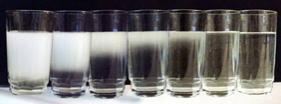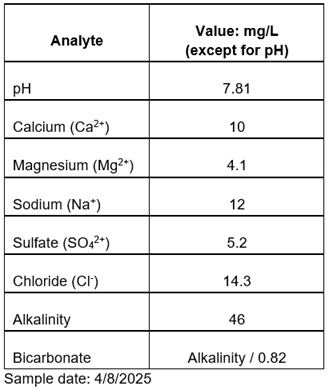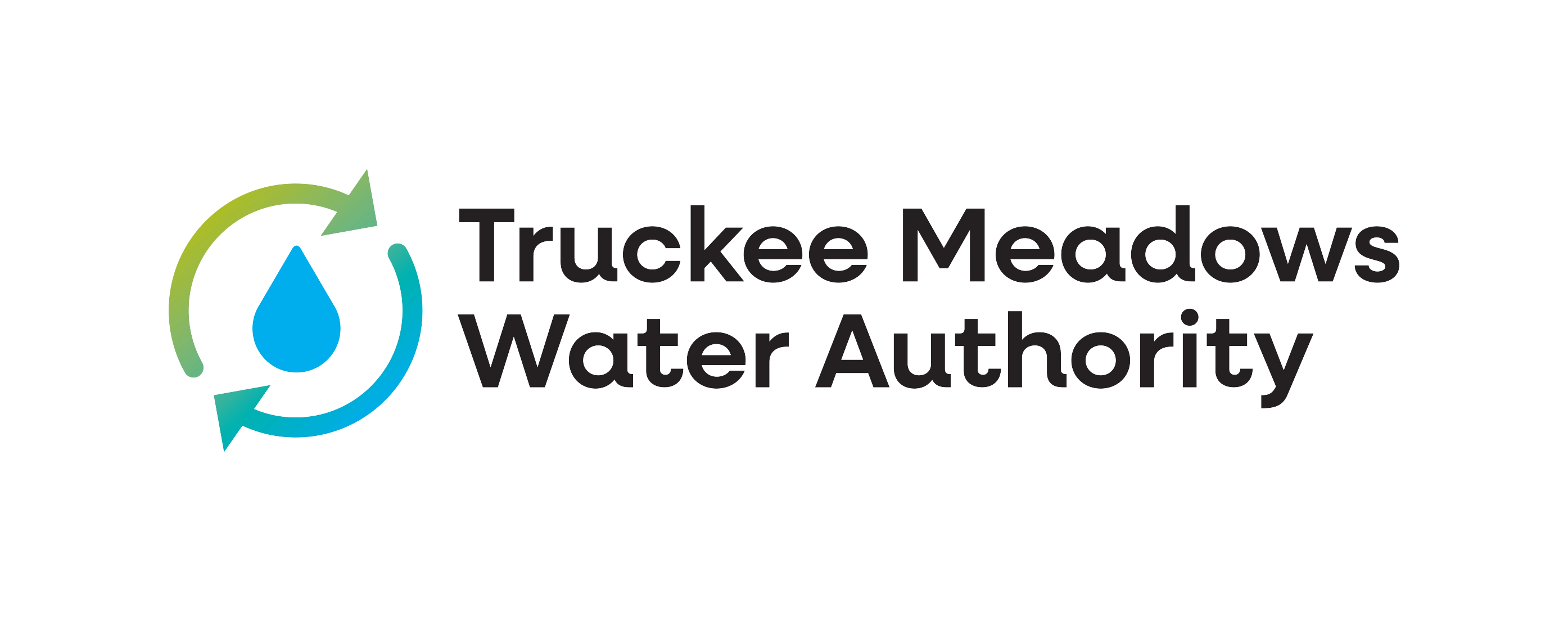Water Quality
Thanks to high-quality water sources, skilled staff, and efficient water treatment facilities, Truckee Meadows Water Authority (TMWA) provides some of the best quality water in the nation. We go to great lengths to ensure your tap water is safe, clean and reliable.
For information on the Environmental Protection Agency’s per- and poly- fluoroalkyl substances (PFAS) rule, click here https://tmwa.com/pfas
For information on the Environmental Protection Agency’s lead and copper rules, click here https://tmwa.com/lcr
To help you more fully understand the quality of the water we provide, we have provided the resources below. Should you have additional questions, please call TMWA's Water Quality Department at (775) 834-8118.
Our annual Water Quality Report is provided to our customers in accordance with the Safe Drinking Water Act, has been compiled to help you understand the water supply and quality issues vital to our area.
Click Here to View the Water Quality Report for Your Location
Click on the colored areas for water quality details in your location or choose from the list below the map.

Drinking Water Standards
| Constituent | MCL (mg/L or ppm) |
|---|---|
| pH | 6.5 - 8.5 (pH units) |
| Magnesium | 150 |
| Nitrite (as N) | 1 |
| Nitrate (as N) | 10 |
| Total Dissolved Solids (TDS) | 1000 |
| Fluoride | 4 (primary), 2 (seconary) |
| Chloride | 400 |
| Sulfate | 500 |
| Asbestos | 7 (MFL longer than 10 um) |
| Color | 15.0 (CU) |
| Cyanide | 0.2 |
| MBAS | 0.5 |
| Odor | 3.0 (TON) |
Metals | |
| Mercury | 0.002 |
| Beryllium | 0.004 |
| Aluminum | 0.2 |
| Chromium | 0.1 |
| Manganese | 0.1 |
| Nickel | N/A |
| Copper | 1.3 (primary), 1 (secondary) |
| Zinc | 5 |
| Arsenic | 0.010 |
| Selenium | 0.05 |
| Silver | 0.10 |
| Cadmium | 0.005 |
| Antimony | 0.006 |
| Barium | 2 |
| Thallium | 0.002 |
| Lead | 0.015 |
| Iron | 0.6 |
| Sodium | N/A |
Volatile Organic Compounds | |
| Vinyl Chloride | 0.002 |
| Benzene | 0.005 |
| Carbon Tetrachloride | 0.005 |
| 1,2-Dichloroethane | 0.005 |
| Trichloroethylene | 0.005 |
| 1,4-Dichlorobenzene | 0.075 |
| 1,1-Dichloroethylene | 0.007 |
| 1,1,1-Trichloroethane | 0.2 |
| cis-1,2-Dichloroethylene | 0.07 |
| 1,2-Dichloropropane | 0.005 |
| Ethylbenzene | 0.7 |
| Chlorobenzene | 0.1 |
| 1,2-Dichlorobenzene | 0.6 |
| Styrene | 0.1 |
| Tetrachloroethylene | 0.005 |
| Toluene | 1 |
| trans-1,2-Dichloroethylene | 0.1 |
| Xylenes | 10 |
| Dichloromethane | 0.005 |
| 1,2,4-Trichlorobenzene | 0.07 |
| 1,1,2-Trichloroethane | 0.005 |
Carbamates and Urea Pesticides | |
| Carbofuran | 0.04 |
| Oxamyl | 0.2 |
Chlorinated Acids Herbicide | |
| 2,4,5-TP (Silvex) | 0.05 |
| 2,4-D | 0.07 |
| Dalapon | 0.2 |
| Dinoseb | 0.007 |
| Pentachlorophenol | 0.001 |
| Picloram | 0.5 |
Chlorinated Pesticides and/or PCBs | |
| Chlordane (tech) | 0.002 |
| Endrin | 0.002 |
| gamma-BHC (Lindane) | 0.0002 |
| Heptachlor | 0.0004 |
| Heptachlor epoxide | 0.0002 |
| Hexachlorobenzene | 0.001 |
| Hexachlorocyclopentadiene | 0.05 |
| Methoxychlor | 0.04 |
| PCBs, Total | 0.0005 |
| Toxaphene | 0.003 |
Diquat and Paraquat | |
| Diquat | 0.02 |
Endothall | |
| Endothall | 0.1 |
Fumigants | |
| 1,2-Dibromo-3-chloropropane | 0.0002 |
| 1,2-Dibromoethane (EDB) | 0.00005 |
Glyphosate | |
| Glyphosate | 0.7 |
SOCs | |
| Alachlor | 0.002 |
| Atrazine | 0.003 |
| Benzo (a) pyrene | 0.0002 |
| Bis(2-ethylhexyl)adipate | 0.4 |
| Bis(2-ethylhexyl)phthalate | 0.006 |
| Simazine | 0.004 |
| SOCs | |
| Dioxin | 3.E-08 |
Rads | |
| Uranium | 0.03 |
| Gross Beta | Annual dose equivalent to the human body or any internal organ may not exceed 4 mrem/yr. |
| Radium 226 | 5 (pCi/L) |
| Radium 228 | 5 (pCi/L) |
| Gross Alpha | 15 (pCi/L) |
Water Quality - Frequently Asked Questions
Before water chlorination millions of people would become ill or die annually from waterborne diseases. Diseases we view as largely obsolete, such as cholera, dysentery, and typhoid became rare once the addition of chlorine became ubiquitous across treatment plants throughout the country.
In the United States water chlorination has been around for over 100 years and first took place in 1908 on Jersey City’s water supply. Along with conventional water treatment, chlorination is highly effective at destroying / inactivating infectious viruses, bacteria, and protozoa.
Truckee Meadows Water Authority (TMWA) is required by the Environmental Protection Agency (EPA) to chlorinate our drinking water. The Maximum Contaminant Limit (MCL) set by EPA is 4.0mg/L. Although TMWA doses much lower than the MCL, it is enough to achieve proper disinfection without imparting a strong “bleach” taste to the water.
Some people may be more sensitive to chlorine taste/odor – listed below are a few ways to mitigate any such taste/odor.
- Simply pour tap water into a pitcher and put in the refrigerator, uncovered. The chlorine will naturally dissipate over a short while and you can enjoy water without the chlorine taste/odor. It is recommended that you consume this water within a couple of days.
- The addition of lemon or lime to your water. The ascorbic acid from lemons or limes will neutralize the chlorine residual, and you can then enjoy the water without any chlorine taste/odor.
- The use of an activated carbon filter like those in a Brita water filter. The activated carbon filter will remove chlorine and you’ll be able to enjoy your water without chlorine taste/odor. Always follow manufacturers’ recommendations regarding maintenance or changing of these filters.
Truckee Meadows Water Authority (TMWA) has complied with Environmental Protection Agency’s (EPA) 2021 Lead and Copper Rule Revision, which required all water systems to create a Service Line Inventory (SLI). The SLI represents both the public and private side of the water meter and all service lines were found to be Non-Lead. Sources used to determine TMWA’s Non-Lead status include install/build date on or after January 1, 1990, lines greater than 2 inches in diameter, visual identification by TMWA distribution staff, design drawings, As-builts, service cards, meter retrofit project, Washoe County Assessor’s data, as well as VODA.ai LeadZero predictive modeling.
Truckee Meadows Water Authority (TMWA) continues to conduct routine lead and copper monitoring as specified in EPA’s 1991 Lead and Copper Rule.
For more information regarding EPA’s Lead and Copper rule or TMWA’s SLI, click here www.tmwa.com/lcr/
Here are a few things to do before you panic and think your water is unsafe to drink:
First, if you have a whole house filtration or softening system, replace any filters or cartridges and maintain according to manufacturer’s guidelines. If the issue still exists, use the bypass valve on your system to turn off the softening or filtration. Flush the pipes at the faucets with cold water for several minutes and re-check. An improvement in the quality of the water indicates your system may need additional maintenance. Refer to manufacturers’ guidelines or contact the manufacturer. The same applies if you have a point of use filter at your sink.
If you do not have a treatment system, or if you have determined that your system is not the culprit, check whether the issue coming from the cold or hot water. Start by flushing the affected tap with cold water for 30 to 60 sec to clear any residual hot water that may be present from the previous use. Then fill a clean glass with cold water and observe. Repeat at 1-2 other faucets. Check the toilets. If the issue is not coming from the cold water, then repeat with the hot water. If the issue is in the hot water, your hot water heater may need to be drained and flushed several times. Typically, manufacturers recommend homeowners flush their hot water heater at least once a year. Always follow the manufacturer’s instructions and safety recommendations.
Plumbing-related issues typically occur only in one or some of the water fixtures on the property. Additionally, if the water quality improves after running the cold water at the affected taps for up to 5 minutes, then the issue is related to the plumbing. Please note that it can take as long as 10 minutes to pull in fresh water to some faucets in the house.
First, determine if the odor is in the hot or cold water. If it’s in the hot water, maintain hot water heater according to manufacturer’s guidelines.
If it’s in the cold water check whether the odor is coming from all faucets. You can also check the water supply at the faucet closest to your water meter. This faucet is typically the hose bib at the front of your property. Run the water at this faucet for 2-3 minutes. Disconnect the water hose if there is one attached and fill a clean glass. If the odor does not exist, flushing your plumbing after removing any aerators and cleaning the plumbing fixtures is recommended. If the odor is strong at the water source, please contact us at 775-834-8118 or waterquality@tmwa.com.
My drinking water smells like bleach.
We use sodium hypochlorite in our treatment process to disinfect the water, and TMWA must maintain a chlorine residual in the distribution system as we’re a public water system. Some people are more sensitive to the smell/taste than others, especially in summer when demand is higher. We test 180 sites throughout our distribution system every month to ensure that the residual chlorine is well within the regulated range and safe for consumption.
There are some ways to help mitigate chlorine taste. Try adding some lemon juice to your water. The ascorbic acid in lemons neutralizes chlorine. An activated carbon filter at the tap or on a pitcher will remove chlorine. Look for an ANSI/NSF-approved filter. Finally, simply letting water sit in an open pitcher in the fridge will allow most of the chlorine to dissipate.
My water smells strongly of bleach in the shower.
The chlorine odor is more noticeable when water temperature increases. Heat causes chlorine to dissipate faster out of the water, so you may notice the odor more while running the hot water during a bath or shower. Despite the strong chlorine odor, the water is still safe to use.
My drinking water smells and tastes earthy or musty like algae.
Surface water from snowmelt and rainfall may have natural odors and tastes. Taste and odor compounds do get more pronounced in late summer/early fall with temperature changes. While our water treatment process can remove most of the impurities found in the water, we unfortunately cannot completely remove all taste and odor compounds. The water is still safe to drink and use. Try adding lemon juice to your water or using an activated carbon filter to improve the odor and taste.
My water smells like rotten eggs.
A rotten egg or sulfur smell coming from a single tap in your house typically comes from unsanitary sink plumbing, garbage disposals, or nozzle screens on a sink spout. One way to check to see if this is the source of the odor is to fill a clean glass with tap water and smell the water in a separate room. If the odor no longer exists, then the odor is likely coming from the plumbing at the sink. To resolve this, flush the cold water at the tap for a few minutes before use, run and freshen up the garbage disposal, or clean the sink and the countertops around the sink.
The white residue comes from naturally-occurring minerals, such as calcium and magnesium, found in water. These are dissolved minerals and do not pose a risk to your health. These minerals can build up on surfaces over time. There are commercially available products to remove the white residues on shower glass and kitchenware caused by minerals. For dishes, mineral deposits can be minimized by using commercial conditioners, liquid detergents in the dishwasher, and by using the air-drying setting on your dishwasher instead of heat-drying, which can bake the carbonates onto glassware. For appliances, clean according to manufacturer’s recommendation. For other surfaces such as countertops and plumbing fixtures, a cleaner designed to remove hardness deposits or a homemade vinegar cleaner can help remove hardness scales.
You can determine the hardness of the water in your area by using our Water Quality Look Up Map.
Hardness of water does not affect the safety or quality of your tap water. Hardness is caused by calcium and magnesium, two naturally-occurring minerals in water. The best way to determine your water hardness is to check TMWA’s Water Quality Look Up Map. Click on your general location and you’ll see the most recent water quality data for your area, including hardness. You can also call our Water Quality Department at (775) 834-8118 or email waterquality@tmwa.com.
Minerals such as calcium and magnesium (hardness) will deposit a scale as the water evaporates while the swamp cooler is in use. The recirculated water in the cooling unit has a higher concentration of minerals as a result of the evaporative process of the unit. Refer to the manufacturer’s guide for installing or using a bleed-off valve, as well as maintaining your swamp cooler. A bleed-off valve allows you to drain some of the recirculated water and replenish with fresh water.
You can determine the hardness of the water in your area by using our Water Quality Look Up Map.
Cloudy or milky water is caused by tiny air bubbles which becomes entrapped in the water. The bubbles will rise to the top and no longer be visible (see picture below). This type of cloudiness can happen more in the winter. When the drinking water is cold, it holds more air. As the water heats up in the plumbing, most of that air is no longer soluble and comes out of the solution as bubbles. While it might be unappealing to the eye it is safe to drink.

TMWA participated in EPA’s Unregulated Contaminant Monitoring Rule 3 (UCMR3) from 2013 to 2015, which required water systems to test for six different PFAS compounds. No PFAS contaminants were detected in our sources from that sampling event using the minimum reporting levels required at that time.
TMWA is currently participating in EPA’s UCMR5 which runs from 2023-2025 and monitors for 29 PFAS contaminants, including PFOS and PFOA. TMWA is seeing a few of the UCRM5 contaminants in some of its sources. It is important to note that a partial data set doesn’t give a complete picture of PFAS levels and therefore isn’t necessarily indicative of PFAS impact.
Please visit our webpage on PFAS for more information: https://tmwa.com/what-are-pfas-pfoa-and-pfos/
We do not add fluoride to our drinking water. Please review our Water Quality Report to see the most up to date information about how much naturally-occurring fluoride is measured in our water. Please note that if fluoride was not detected in our water system for that service year, it will not be listed on the report.
Tap water is every bit as safe as bottled water. In fact, it’s tested more, according to the American Water Works Association (AWWA). The cost difference between tap water and bottled water is also significant. TMWA charges less than $2.00 per 1,000 gallons of treated water (first-tier residential rate), while a liter of bottled water costing roughly $1 which equates to $3,780 for 1,000 gallons of bottled water. Fill up a reusable bottle with tap water to save money and help the environment by reusing containers instead of disposing of them.
Check whether the discolored water is coming out of all cold water faucets. Discolored water may be accompanied by sediments. If it is only coming out from one faucet, remove the aerator if there is one and flush that faucet until it clears up.
Increased flows in the water distribution pipes can disturb mineral, such as iron, deposits from within pipes and cause water to change colors. An increase of water flow can be due to fire hydrant flushing maintenance or firefighting activities. Discolored water has no health impact, but you may prefer to flush until it clears before using it.
While your water has a discoloration, it’s important not to use hot water because sediment can collect in the hot water tank. Avoid using your appliances so sediment so the lines don’t get clogged. It’s also important not to do laundry because clothes can become discolored during the time the water is colored.
The water should become clear within several hours. Every 30 minutes or so check the water for clarity by running the cold water for about 5 minutes. Once the water is clear, flush the pipes in your house by running all cold water taps for several minutes. If you are still experiencing discolored water after several hours, please call the Water Quality Laboratory at 775-834-8118 or email waterquality@tmwa.com.
The lining to any braided hose (faucet connector, toilet connector, etc.) will deteriorate over time and will leave black oily or rubber particles in the water. The particles may stick to surfaces on contact. The bladder of the expansion tank on your hot water heater is made of black rubber and can also deteriorate over time. Check the integrity of any braided hose or any attachments that contains a black rubber lining and replace.
Pink or orange ring
This type of ring is caused by bacteria in the toilet. The best way to remove this ring is to use a toilet bowl cleaner, and keep moist surfaces wiped and scrubbed down. Adding 3-5 tablespoons of chlorine bleach to the toilet bowl water and then flushing can help. A toilet cake containing disinfectant will also keep the bacteria at bay.
Black film or ring
This film can be the result of many factors, some of which are internal to the home, such as a water softener, age of the fixture, and plumbing materials. Black slime is usually mold or mildew that thrive in moist, wet environments. This film can be cleaned with a commercial cleaner that contains a disinfecting agent, such as chlorine bleach.
Black particles in the toilet can also be an indication the deterioration of the flapper valve, the rubber lining of the braided toilet connector, or the diaphragm.
Yes, it is a good idea to flush your plumbing with both hot and cold water as odor and impurities can build up with time of no use. Open all faucets for 5 to 10 minutes to pull in fresh water and flush the toilets several times.
Please call TMWA’s mainline at 775-834-8080 and select option 2. A customer representative will assist you from there.
The values in the table below represent our most recent annual sampling from our Chalk Bluff water treatment facility. This is our main water treatment plant that supplies water to the majority of our communities. However, as summertime demands ramp up our production, we also turn on groundwater wells to help augment our supply. As you may be well aware, this can and does change the water chemistry a bit depending upon your location to any wells that may be running, and the percentage of surface/groundwater you receive. While your neck of the woods shouldn’t change much, it is dependent upon demands, and fire flows as to which wells will turn on. If you have additional questions, please call the Water Quality Laboratory at 775-834-8118 or email waterquality@tmwa.com.

TMWA
We provide safe drinking water to our customers. If your plants or fish require special water chemistry, please consult with an expert that can help you adjust the water accordingly.
Since the 1800s chlorine has been used in the United States to safely and effectively disinfect drinking water. Chlorine prohibits microbiological activity and prevents disease-causing organisms from multiplying. Today, most utilities use chlorine to disinfect drinking water, under the regulation of the EPA. Studies indicate that chlorine is a safe and effective disinfectant for drinking water and TMWA keeps the chlorine dosage as low as possible while continuing to maintain adequate disinfection. Consult with your physician if you are immunosuppressed due to cancer treatment, organ transplant, HIV/AIDS or other immune system disorders regarding drinking tap water and what is best for you. If you don’t care for the taste of tap water, try a drop of lemon juice or leave your water in an open pitcher before drinking.
Tetrachloroethylene or PCE is a chemical that can be discharged from factories and dry cleaners. If not handled properly by these industries, it can leach into underground drinking water supplies. PCE is not found in the Truckee River, which supplies most of our region’s drinking water. Currently, five well sites employ a treatment process where PCE is removed to a non-detectable level prior to entering our water system. The cost for PCE removal is not reflected on TMWA bills, but is paid for by the Central Truckee Meadows Remediation District via property tax bills.
Our Water Quality Laboratory does not accept samples from the public. We do test 180 sites throughout our distribution system monthly. The water quality team looks at pH for corrosion control, residual chlorine to ensure disinfection of the water from bacteria, turbidity for clarity of the water, the temperature, and tests for total coliform bacteria. We also rigorously test for other contaminants such as metals and organic compounds per our state’s compliance schedule. Thus, you can be rest assured the water entering your home or business is safe to consume and use.
Please review our Water Quality Look Up Map for other parameters in your area, such as hardness, and review the Water Quality Report. If you are seeking more specific testing of the water from your house or business in particular, there are other water testing labs in the Reno-Sparks area that can provide extensive testing that will meet your needs.
Common questions to answer before calling TMWA:
- Is the taste, odor, or color coming from all faucets in the house?
- Is the taste, odor, or color coming from the cold water, hot water, or both?
- When did I first notice the taste, odor or color?
- How does my water taste or smell (musty, earthy, etc)?
You can contact the Water Quality Laboratory at 775-834-8118 or email waterquality@tmwa.com.
